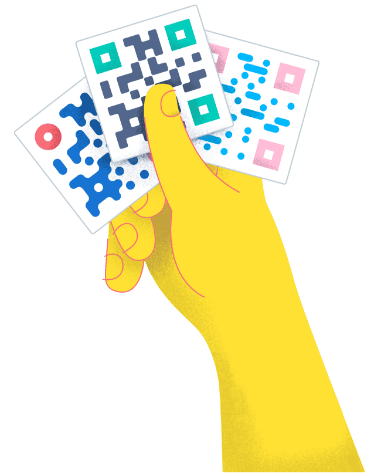- Best Practices ●
- COVID-19 ●
- Industry Trends ●
- Partners ●
- Product ●
Create More Valuable Instruction Manuals With QR Codes
Instruction manuals can make or break the customer experience. They’re the deciding factor in whether a customer uses a product or puts it back in the box and forgets about it, whether unboxing a gift is fun or frustrating, and whether customers see you as caring or careless.
A good customer experience can lead to loyalty, more purchases, and positive reviews. A user guide that goes above and beyond—with extra convenience, design flair, or fun—brings even more value.
Increasingly, businesses are upgrading their instruction manuals with new tech. QR Codes enable you to share instruction manuals anywhere, in any content format, and with interactive elements.
Read on to learn how QR Codes can level up your user guides.
What’s a QR Code, and how does it work?
QR Code stands for “Quick Response Code.” Each QR Code is an image you can scan with a smartphone to access information—such as a website URL, barcode, document, or password—quickly.
QR Codes have been around longer than most people think. The history of QR Codes began in 1994 in Japan, where the company DENSO WAVE invented them to track and label automotive parts. They made the technology public the next year, and it was soon in use everywhere from factories to supermarkets.
Their adoption in the rest of the world was a little slower. But, during the COVID-19 pandemic, QR Code usage accelerated, as we used it for everything from vaccine records to restaurant menus.
Although the pandemic has settled down, QR Code usage hasn’t lost steam. QR Codes are even popping up to manage security at the Paris Olympics. And for those of us who are aiming for profits rather than gold medals, QR Codes can improve business growth.
QR Code vs. Barcode
The key difference between QR Codes and Barcodes is how much information they hold.
Barcodes are rectangles of black and white stripes. They’re usually one-dimensional, which means you can only scan them horizontally with a specially designed scanning device.
They can encode up to 100 letters or numbers, so they’re most effective for small inventories where you only need basic labels. Because you need a Barcode scanner to use them, they work well for internal processes, but you can’t share them with customers easily.
QR Codes can hold much larger amounts of data. They’re two-dimensional, which means they are scannable horizontally or vertically, and their square shape reduces the chance of scanning errors.
Best of all, anyone with a mobile device can scan a QR Code. They work for a much wider audience.
Dynamic vs. Static QR Codes
There’s more than one type of QR Code.
The earliest type is Static QR Codes. They store fixed information, so once you’ve generated the QR Code, you can’t change it.
Dynamic QR Codes are more flexible. You can change and update the content that the code links to, whether it’s an image, video, PDF, store information, social media profile, or web page.
The other key difference between Static and Dynamic QR Codes is that you can track Dynamic QR Codes. You can collect data such as where people are scanning the code, which times of day are most popular, and what actions people take next.
Why we love QR Codes on instruction manuals
QR Codes have begun to supplant Barcodes because they’re flexible, accessible, and hold a substantial amount of information. Those are the same qualities that make them so useful for instruction manuals and product information.
Let’s dive into some of the ways that QR Codes improve user guides.
Digitize instructions for easier access
QR Codes are more portable than bulky, printed manuals. They don’t have page number limits. Once users scan a QR Code, they can download its information, carry it around, and access it from anywhere. That’s especially useful for hands-on information, such as furniture assembly instructions, recipes, or safety guides.
Customers can also choose how they want to display the instructions. For example, someone with vision impairments might scan the QR Code with a tablet instead of a phone for better readability. Or, it may be easier for someone to pull up instructions from their smartphone when needing to quickly refer to recipe instructions in the kitchen.
Quickly identify pieces and parts
Ever found yourself staring at an instruction manual, wondering what the difference is between screw 1A-X and 1B-X, and whether you even care anymore?
Struggling to match instructions to parts is often a pain point for consumers. But QR Codes mean that you can give them more support.
Instead of showing a black-and-white sketch of parts, you can use a QR Code to link to photos, videos, or even 3D models. Users can zoom in and rotate images for even easier identification. And, as augmented reality tech develops, one day soon, you could even use AR to identify parts through a smartphone camera.
Add audio and video aids to support written instructions
Paper user guides aren’t just bulky; they’re also inaccessible to a lot of people.
If someone has a visual impairment, they could struggle to read printed text in a fixed size. If English isn’t their mother tongue, they might prefer to access instructions in a different language. And some people can’t process written information well.
With QR Codes, you can link customers to a range of formats, translations, and additional information. Instead of reading instruction manuals, they could use a text-to-speech reader, listen to an audio guide, or watch an instructional video.
Once you have the content in place, sharing user manuals and tutorials via QR Codes can improve your brand’s accessibility.
Minimize paper waste
Consumers may damage, lose, or throw away paper product manuals without even realizing it. What’s more, paper instructions have an environmental footprint that’s incompatible with the sustainability goals of many modern brands.
But QR Codes stick around. You can print them on smart packaging, add them to an in-package invoice, or even engrave a QR Code on your product.
Over 90% of brands surveyed say they want to use connected packaging with QR Codes. It’s a key part of their marketing strategy and their sustainability targets.
Collect consumer feedback
QR Codes can link to any kind of digital content—including interactive surveys and quizzes. In addition to sharing user manuals, you can use QR Codes to find out more about the user experience.
QR Code surveys often have a high response rate because they’re easy for people to access.
When you print a QR Code on product packaging, it means that customers are likely to fill out the survey while a purchase is still fresh in their minds. You’ll get real-time information about product performance, quality of user guides, and overall customer experience.
How to create a QR Code
Sharing instruction manuals via QR Code is just the first step. You can upgrade the experience for your customers even more with custom URLs and designs.
QR Code Generator PRO walks you through the basic steps to create QR Codes, plus extra design features.
- Decide whether you want to track how people interact with your QR Code.
- Choose the destination for your QR Code: Is it a URL, email address, PDF, video, image, MP3, or something else? This could affect whether you use a Static or Dynamic QR Code.
- Edit the QR Code itself. You can alter the color, framing, and even shape to match your branding. You can even add your brand logo!
- Download the finished QR Code to use on your products, marketing, packaging, or paperwork.
If you’re working on a major campaign with a lot of content, you can also generate QR Codes in bulk.
QR Code best practices to guarantee success
QR Codes are intended to make life as easy as possible. You can increase their effectiveness even more by following these best practices.
- Check readability. Your QR Code will be less effective if you choose hard-to-see colors or drop below the minimum QR Code size.
- Choose the resolution you need for your QR Code. If you’re planning to add the QR Code to printed packaging or manuals, then it will need to be a print-quality download.
- Include a call to action. Some custom frames include instructions to help users out, like “Scan Me” or “Leave a Review.”
- Test the QR Code. Wherever your QR Code is displayed, check that it’s scannable on a range of devices and in different lighting conditions.
Create Dynamic QR Codes With QR Code Generator PRO
Instruction manuals are a must, especially for complex products with many parts. However, long and complicated paper documents can be frustrating to deal with—and can easily be lost or misplaced, rendering them useless. QR Code manuals digitize information into a shareable, easily accessible format, and give businesses the option to include audio and video aids that wouldn’t be possible with a traditional paper manual.
QR Code Generator PRO has the power and flexibility to create QR Codes for any content. Whether you’re sharing PDF user guides, instructional videos, or feedback surveys, Dynamic QR Codes are an easy and eye-catching way to engage your customers.
Start creating better instruction manuals and get started with the QR Code Generator PRO today.






 Add custom colors, logos and frames.
Add custom colors, logos and frames.

